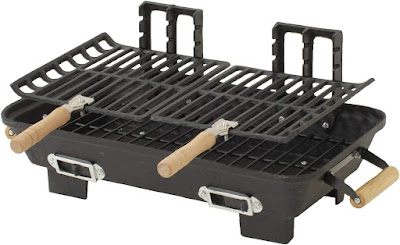
There are big names
in the Chainsaw product line, like Stihl and Husqvarna for the
professional loggers, with Echo and Poulan targeting the home user
market segment. And there are not-so-big names such as Craftsman
(which used to be the Sears brand, and is now available at Lowe’s), Ryobi
(available at Home Depot), and a whole bunch of “Me Too” Chinese
brands that you can find online.
For context, I’ve used
my Ryobi 3716 chainsaw to fell trees, cut firewood, and remove debris
preventing access. My
Trail Life troop has a few “work days”
where we assist other organizations by cutting firewood, and my Ryobi has held up alongside the Stihl, Husqvarna, Poulan,
Crafstman, Homelite, and Echo saws the other dads bring. This isn’t
saying the Ryobi is better, only that it isn’t any worse than other
established brands. My neighbor has a BlueMax (available at Lowes)
brand saw, and it too worked just fine when we were clearing his
backyard.
With all this
comparative experience over the years, I wouldn’t say that the
Ryobi 3716 is a “must buy,” as there are plenty of reasonable
alternatives in the same price bracket. For example if you have a
Lowe’s near you but not a Home Depot, a Craftsman or BlueMax chainsaw
might make a lot more sense in your situation. But if you do have a
Home Depot as your nearest major home improvement store, perhaps it’s the right option for your situation.
The Ryobi 3716 is
aptly named. The 37 is for 37 cubic centimeters of displacement, and
the 16 is for the 16” bar size. It comes in at 12 pounds, which
isn’t ultra-light for a chainsaw, but is much handier than the 20+
pound McCulloch chainsaw my dad let me use to cut firewood. In the
16” bar range, the 37CC engine on the Ryobi 3716 is completely
adequate, and I would not recommend getting a smaller saw unless you
are also stepping down to a 14” bar. A more powerful saw will cut
faster (given equal blade sharpness), but not noticeably so over the
course of a homeowner response to a few trees falling. If you were
going to be in a job where time is money, then the chainsaw would become a
time sink, and you should get a “top tier” chainsaw.
The Good
The initial price is
cheap for a chainsaw, and is a very good value.
Consumable costs
are also very good, as Ryobi is able to use the “Powercare” line of blades
and bars, as well as Oregon blades and bars. My buddy with a
Husqvarna pays nearly 37 dollars a blade, and I can buy a two pack for just over half that.
Other consumable
parts, such as spark plugs and air filters, are cheap and available
due to Home Depot carrying them, and after 5+ years of use, I should
probably get a
tune up kit for it.
The Bad
After Hurricane
Helene, I found myself needing to do two cuts to get through the
trunk of large trees. If you have a lot of work to do, with two foot diameter trees, a more powerful saw with a longer blade is probably a
better option. This was never really a problem before, as all of my
chainsaw work up to that point had been pre-planned on my schedule.
But in a disaster response, sometimes I wished for a 20” bar as
that extra 4 inches of cutting length would have come in handy quite
a bit, and a Craftsman 20 inch chainsaw with 46cc engine is only
about 50 to 60 dollars more. However, the blades and bars get more
expensive as well (to get more, one must pay more).
The Interesting
If you want a real German or Swedish chainsaw, you’ll pay top dollar for one. Pretty much all of the affordable chainsaws, regardless of brand, are made in China, and brands that want to build on brand recognition and brand equity keep a tight reign on their original equipment manufacturer (OEM) quality control. Ryobi is no different in this regard; the Ryobi name is Japanese, but Ryobi power tools in North America is owned by a Hong Kong conglomerate.
If you find a brand you know nothing about, look up a YouTube review or two before purchasing. It doesn’t save you any money in the long run if the saw needs the expensive brand blades or parts.
Prepping Thoughts
To be prepared with a chainsaw you also need to stock fuel, bar oil, spare blades, and at least one spare bar. I recommend spending the money on a pre-mix fuel (I use
TrueFuel 50:1 92 octane, no ethanol) as it lasts a long time, and bar oil lasts indefinitely. If find yourself without bar oil, you can substitute normal car engine oil, but as it is thinner you’ll need refill more often.
If you don’t have
a chainsaw at all, and live where windstorms can knock trees down and
lock you in (like what happened recently in the Pacific Northwest), or
live where hurricanes are a known risk (pretty much all of the
South), or even where Nor’easters can hit and drop trees, you
probably should have a chainsaw in your resiliency preps, and it
probably should be a two cycle gas chainsaw unless you have a robust
power generation setup where you could recharge a bunch of 40 volt
lithium battery packs. After Helene, no one was using electric
chainsaws after day two, as there were more pressing needs for
electricity, like refrigeration.




































